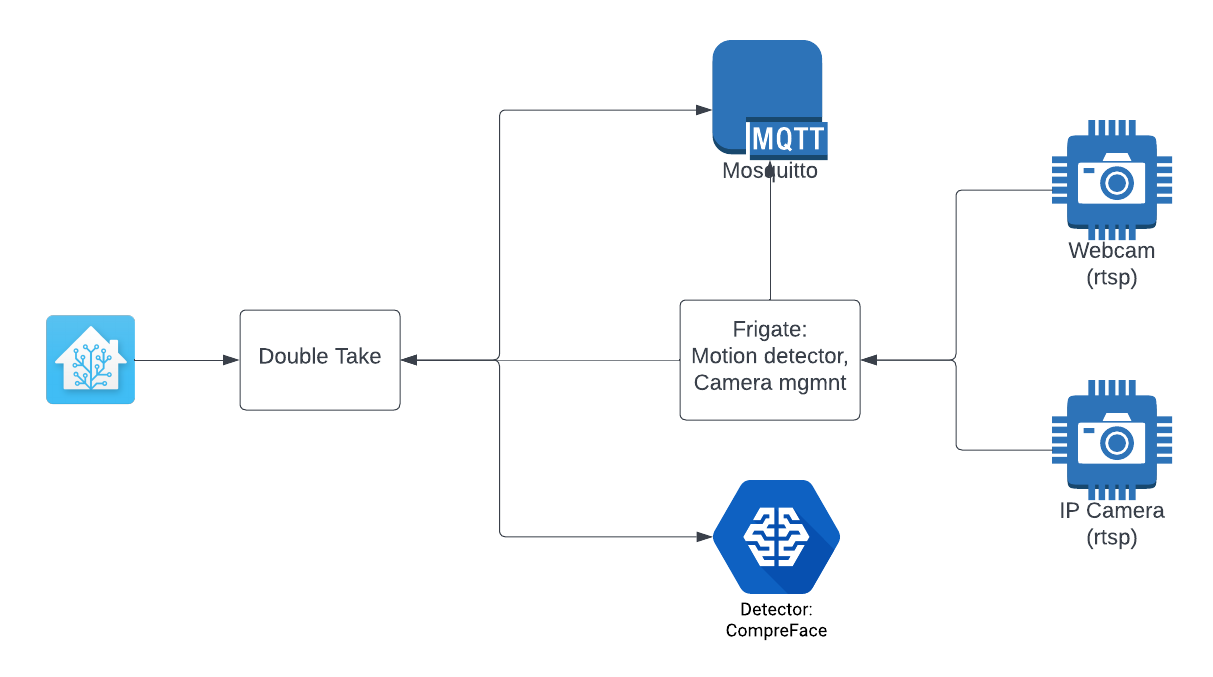Setup for facial recognition support in Home Assistant. We will setup a VM with the following support servers:
- MQTT Server
- Frigate
- CompreFace / Deepstack
- Double Take
We will use the camera of laptop or later the camera of raspberry Pi.
Username: face Password: support33
See Installation
The network adapter must be an "e1000" to see the "enp0s3" adapter in Linux.
When you have downloaded the OVA-file with the installed packages (rtsp-simple-server, Frigate, CompreFace and Double Take ), then you need to perform only the configuration of IP addresses. You need to change the IP addresses to the IP addresses of your guest OS.
To retrieve your unique DHCP IP address:
sudo dhcpcd
To get the IP address:
ip a
Normally it is the second IP address of the enp0s3 interface.
Search for "enp0s3" to get its IP address.
Now you can ssh into the guest OS from a terminal:
ssh face@<IP address>
Password: support33
retrieve the IP address of your guest:
ip a
goto directory ./rtsp-simple-server and change the ip-adressen in the start.sh file of the guest. When changed, run:
sudo ./startup.sh
Ssh into the guest from a second terminal and configure frigate, change the IP addresses:
sudo vi /etc/frigate/frigate.yml
With your webcam rts-server only:
mqtt:
host: 192.168.1.41
port: 1883
cameras:
back:
ffmpeg:
inputs:
- path: rtsp://192.168.1.41:8554/stream
roles:
- detect
- rtmp
hwaccel_args: ''
detect:
width: 1280
height: 720
Using a ESP32-CAM camera only:
mqtt:
host: 192.168.1.41
port: 1883
cameras:
back:
ffmpeg:
inputs:
- path: http://192.168.1.11:81/stream
roles:
- detect
- record
input_args: -avoid_negative_ts make_zero -fflags nobuffer -flags low_delay -strict experimental -fflags +genpts+discardcorrupt -use_wallclock_as_timestamps 1 -c:v mjpeg
output_args:
record: -f segment -segment_time 10 -segment_format mp4 -reset_timestamps 1 -strftime 1 -c:v libx264 -an
rtmp: -c:v libx264 -an -f flv
rtmp:
enabled: false
detect:
width: 640
height: 480
fps: 20
Change all the IP addresses in the above configuration and start frigate:
cd frigate
sudo docker compose up
Frigate is now accessible through URL http://:5000
Ssh into the guest from a third terminal to start Deepstack:
cd deepstack
sudo docker compose up
Ssh into the guest from a fourth terminal to start DoubleTake:
cd double-take
sudo docker compose up
You can now go to Double Take: http://:3000/config to configure it:
mqtt:
host: 192.168.50.178
frigate:
url: http://192.168.50.178:5000
detectors:
deepstack:
url: http://192.168.50.178:8000
timeout: 15
opencv_face_required: false
Don't forget to change the IP addresses to your Guest IP.
Next time you'll need only to start the rtsp-simple-server, because all other processes will be automatically started by docker.
- Try the whole process on a Raspberry Pi (need a Pi with minimal 4G memory).
- Replace CompreFace with DeepStack
- Instead of Facial recognition, try number plate recognition.
- https://www.gyan.dev/ffmpeg/builds/
- https://gist.github.com/edjdavid/513cbee3f9a10cd06e9e49e8bdfa0f96
./ffmpeg -f dshow -rtbufsize 1024M -framerate 30 -video_size 640x480 -vcodec mjpeg -i video="Integrated Camera" -f rtsp -rtsp_transport tcp rtsp://192.168.80.128:8554/stream
./ffmpeg -f dshow -rtbufsize 1024M -framerate 30 -video_size 640x480 -vcodec mjpeg -i video="UC CAM75FS-1" -f rtsp -rtsp_transport tcp rtsp://192.168.80.128:8554/stream
Using both your ESP32-CAM and the web-camera to your frigate configuration:
mqtt:
host: 192.168.1.41
port: 1883
cameras:
front:
ffmpeg:
inputs:
- path: http://192.168.1.11:81/stream
roles:
- detect
- record
input_args: -avoid_negative_ts make_zero -fflags nobuffer -flags low_delay -strict experimental -fflags +genpts+discardcorrupt -use_wallclock_as_timestamps 1 -c:v mjpeg
output_args:
record: -f segment -segment_time 10 -segment_format mp4 -reset_timestamps 1 -strftime 1 -c:v libx264 -an
rtmp: -c:v libx264 -an -f flv
rtmp:
enabled: false
detect:
width: 640
height: 480
fps: 20
back:
ffmpeg:
inputs:
- path: rtsp://192.168.1.41:8554/stream
roles:
- detect
- rtmp
hwaccel_args: ''
detect:
width: 1280
height: 720
The front configuration is the ESP32-CAM. In the path variable, you need to replace the IP address of your ESP32-CAM
The back configuration is your web-camera (or USB camera).
